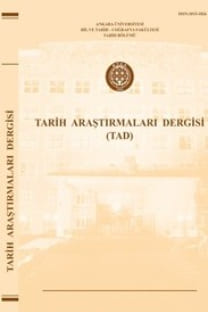İmparator Diocletianus’un “Tavan (En Yüksek) Fiyatlar Fermanı” “Edictum de pretiis Rerum Venalium”
Roma İmparatorluğu, Diocletianus, Ekonomi, Tavan Fiyatlar, Enflasyon
Diocletian’s Edict on Maximum Prices “Edictum de pretiis Rerum Venalium”
Roman Empire, Diocletianus, Economy, Maximum Prices, Inflation,
___
- BALK, B.M. Price and Quantity Index Numbers: Models for Measuring Aggregate Change and Difference, Cambridge University Press, Cambridge, 2008.
- BELLINGER, A.R. – Bruun, P, - , “Late Roman Gold and Silver Coins at Dumbarton Oaks: Diocletian to Eugenius“, Dumbarton Oaks Papers, Vol. 18 (1964), 161-236.
- CRAWFORD, Michael H. - Reynolds, Joyce, “The Publication of the Prices Edict: A New Inscription from Aezani“, The Journal of Roman Studies, Vol. 65, 1975, 160-163.
- CRAWFORD, M. H. – Reynolds, J. “The Aezani Copy of the Prices Edict” Zeitschrift für Papyrologie und Epigraphik, Bd. 26, 1977, 125-151.
- DOYLE, E. J., “Two New Fragments of the Edict of Diocletian on Maximum Prices”, Hesperia, Vol. 45, No. 1, 1976, 77–97.
- ECK, W. – Engelmann, H. – vd, “Fourth Century Prices: New Evidence and Further Thoughts”, Zeitschrift für Papyrologie und Epigraphik, Band 76, Bonn, 1989, 69 – 76.
- ERIM, Kenan T. – Reynolds, J. - Wild, J. P. – Ballance, M. H., “The Copy of Diocletian's Edict on Maximum Prices from Aphrodisias in Caria”, Journal of Roman Studies, vol. 60, 1970, 120 – 141.
- ERIM, Kenan T. – Reynolds, J. – Crawford, M., “Diocletian's Currency Reform: A New Inscription”, Journal of Roman Studies, vol. 61, 1971, 171 – 177.
- Fathers of the III. and IV. Centuries, “Lactantius”, Cleveland, 1886.
- GRASER, Elsa R. “Two New Fragments of the Edict of Diocletian” Transactions and Proceedings of the American Philological Association, vol. 71, 1940, 157 – 174.
- HENDY, Michael, F. Studies in the Byzantine Monatery Economy, Cambridge University Pres, Cambridge, 1985.
- KENT, Roland G., “The Edict of Diocletian Fixing Maximum Prices”, University of Pennsylavania Law Review and American Law Register, Vol. 69, No:1, 1920, 35 – 47.
- LAUFFER, S., Diokletians Preisedikt, Berlin, I97I.
- LEAKE, W.M. An Edict of Diocletian Fixing A Maximum Prices Throughout The Roman Empire AD. 303, London, 1826.
- LEWIS, N. – Reinhold, M. Roman Civilization, vol. II, Columbia University Pres, New York, 1990.
- MACPHERSON, I. W., “A Synnadic Copy of the Edict of Diocletian, The Journal of Roman Studies, Vol. 42, 1952, 72-75
- MICHELL, H. “The Edict of Diocletian: A Study of Price Fixing in the Roman Empire”, The Canadian Journal of Economic and Political Science, vol. 13, no: 1, 1947, 1 – 12.
- MOMMSEN, Theodor, “The Plataian Fragment of the Edict of Diocletian”, The American Journal of Archaeology and of the History of the Fine Arts, Vol. 7, No: 1 / 2, 1891, 54 – 64.
- MOUSOURAKIS, G. The Historical and Institutional Context of Roman Law, Hempshire, 2003
- ROSTOVTZEFF, M.I., Social ve Economic History of the Hellenistic World, Oxford, 1953.
- WASSINK, Alfred, “Inflation and Financial Policy under the Roman Empire to the Price Edict of 301 AD”, Historia: Zeitschrift fir Alte Geschichte, vol. 40, no: 4, 1991, 465 – 493.
- WEST, Louis C., “Notes on Diocletian’s Edict”, Classical Philology, vol. 34, 1939, 239 – 245.
- ISSN: 1015-1826
- Yayın Aralığı: 2
- Başlangıç: 1963
- Yayıncı: Levent KAYAPINAR
Babalar ve Oğullar: IV. Andronikos Palaiologos ve Savcı Çelebi’nin İsyanı (1373)
İmparator Diocletianus’un “Tavan (En Yüksek) Fiyatlar Fermanı” “Edictum de pretiis Rerum Venalium”
Gilân Sorunu ve Osmanlı-Safevi Devletleri Arasındaki Yazışmalar
Bizans ve Osmanlı Kaynaklarında Gâzi Evrenos Bey’in İmajı Hakkında Bir İnceleme
Yunanistan’ın Ekonomik ve Siyasî Hayatına Yön Veren Anadolu Kökenli Bazı Sermaye Sahipleri
Gazi Süleyman Paşa Vakfı’nın Mali Tarihi ve 17. Yüzyılda Trakya Tarımsal Ekonomisi
Don Kazaklarının Azak’ı İşgalleri (1637-1642)
Merkezîleşme Politikaları Sürecinde Yurtluk-Ocaklık Sisteminin Değişimi
